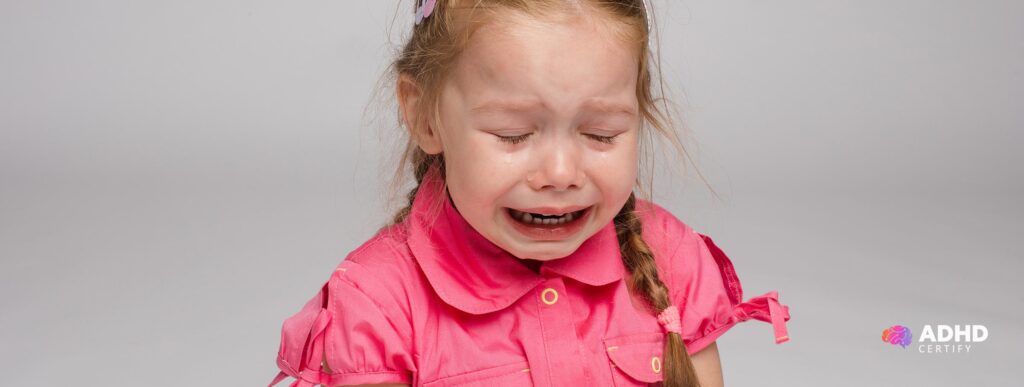ADHD shutdowns and ADHD meltdowns both emerge from intense emotional overwhelm.
But what sets them apart, and why does it matter?
You may wonder: is my teen zoning out because they are calm, or because they are shutting down?
Or, is this meltdown misread as misbehaviour when it’s actually distress?
The difference between ADHD shutdown and meltdown lies in how the distress presents:
- Shutdowns are internal and quiet
- Meltdowns erupt outwardly
Both are valid reactions tied to ADHD emotional dysregulation, often misunderstood.
“A UK government briefing done on 01/07/2024 confirms that ADHD affects around 2 to 5 percent of school-aged children and up to 4 percent of adults, often with symptoms like emotional dysregulation that can disrupt daily life (Northern Ireland Assembly, 2024)”.
Understanding shutdowns and meltdowns helps parents, teachers, partners and adults with ADHD respond with empathy and effective support.
Let’s begin by exploring the emotional overload behind both shutdowns and meltdowns.
Understanding the Emotional Overload Behind ADHD Shutdowns and Meltdowns
Emotional dysregulation is at the heart of both ADHD shutdowns and ADHD meltdowns, but they show up in very different ways. To support someone effectively, you first need to recognise the shape their overwhelm takes.
What is an ADHD Shutdown?
An ADHD shutdown is an internal response to overwhelming stress or sensory overload. Instead of reacting outwardly, a person may withdraw, become quiet, or temporarily lose the ability to communicate or process information. It is a protective response where the brain slows down to cope.
Common signs of a shutdown:
- Sudden silence or withdrawal
- Difficulty speaking or thinking clearly
- Emotional numbness
- Avoidance of interaction
- Physical stillness or fatigue
Our clinicians at ADHD Certify UK note that shutdowns can affect both children and adults when demands feel too high or unpredictable.
What is an ADHD Meltdown?
An ADHD meltdown is an external emotional response to overwhelming stress or sensory overload. It can look like anger, crying, shouting, or a sudden loss of emotional control. Meltdowns are not “tantrums” they are a sign of an overwhelmed nervous system.
Common signs of a meltdown
- Shouting, crying, or frustration
- Physical restlessness or agitation
- Emotional reactions that feel uncontrollable
- Difficulty calming down even after the trigger is gone
Meltdowns happen when coping strategies run out and emotional regulation becomes too difficult to maintain.
ADHD Shutdown vs ADHD Meltdown: Key Differences
Both shutdowns and meltdowns are responses to overwhelm, but they look very different. Shutdowns turn inward, the person may go quiet or freeze. Meltdowns are outward emotions that may spill over loudly or visibly. Understanding the difference means support can be more compassionate and effective.
Here’s a quick breakdown:
| Feature | ADHD Shutdown | ADHD Meltdown |
| Reaction Type | Internal and withdrawn | External and expressive |
| Common Behaviours | Zoning out, silence, dissociation | Yelling, crying, physical outbursts |
| Misinterpreted As | Stubbornness, laziness, being rude | Tantrum, aggression, poor behaviour |
| Communication Ability | Often unable to speak or respond | May be loud but not always coherent |
| Typical Triggers | Social overwhelm, fatigue, sensory input | Sensory overload, frustration, buildup |
| What Helps Most | Space, non-verbal reassurance | Calm tone, reduced stimuli, grounding |
Both reactions are part of the ADHD spectrum, and recognising the difference between ADHD shutdown and meltdown can lead to more compassionate, effective responses.
Why These Reactions Happen: The Science Behind Shutdowns and Meltdowns
ADHD-related challenges with emotional regulation, sensory sensitivity, and executive function all play a role in these intense responses.
The Role of Executive Function and Overwhelm
People with ADHD often struggle with executive function, the brain’s management system for planning, switching focus, and controlling impulses.
When too much information hits at once, the brain can become overwhelmed. This can lead to either shutting down or melting down, depending on how the person copes with stress.
Decision fatigue, too many demands, or a change in routine can all cause the brain to freeze or react impulsively.
ADHD Emotional Dysregulation and Stress Response
ADHD emotional dysregulation means the brain has a harder time keeping feelings in check. Frustration builds faster. Small problems can feel like massive threats. When stress levels peak, the nervous system goes into survival mode.
- In shutdowns, this can look like emotional numbing or dissociation.
- In meltdowns, it can look like shouting or crying. Both are expressions of the same underlying overload.
Impact of Sensory Overload and Environmental Triggers
Sensory input hits differently for people with ADHD. Bright lights, background noise, or even uncomfortable clothing can tip someone over the edge.
What might seem minor to others can be unbearable for someone with heightened sensory sensitivity. When these factors combine with stress, they often trigger either a shutdown or a meltdown.
Recognising Triggers and Warning Signs Early
Noticing the early signs of distress can help prevent escalation and support regulation in both children and adults. Many ADHD coping strategies rely on spotting what’s coming before it hits full force.
Signs a Shutdown Is Approaching
Look out for:
- Sudden withdrawal or going quiet
- Silence during group conversations
- Frozen or blank facial expression
- Hiding under blankets or in small spaces
- Avoiding eye contact or social engagement
These signs are the nervous system beginning to shut off. It’s not rudeness. It’s self-protection.
Signs of an Impending Meltdown
Watch for:
- Pacing or physical agitation
- Vocal frustration or increased volume
- Repetitive movements like hand-flapping or clenching fists
- Sudden refusal to follow instructions
- Emotional outbursts, often tied to a buildup of stress
A meltdown isn’t always loud at first, the early signs can be subtle but grow fast without support.
Common Triggers for Both
The following triggers often lead to either response:
- Transitions between tasks or places
- Noise or unpredictable environments
- Social demands, especially group settings
- Fatigue or skipped meals
- Sensory input, such as lights, textures, or smells
These experiences can stack quickly, overwhelming the nervous system and leading to a shutdown or meltdown if not recognised and redirected early.
How to Support Someone in an ADHD Shutdown
When a person shuts down, they are overwhelmed internally and may not be able to communicate what they need.
Practical support tips:
- Reduce noise and pressure to offer a quiet, safe space
- Give short, simple choices (“Would you like water or a break?”)
- Avoid rapid questions or demands
- Let them take time to speak, silence can help
- Provide reassurance without forcing interaction
Offer Safety and Space Without Demanding a Response
When a shutdown happens, the person may need distance, both physically and emotionally. Offer a calm presence nearby. Let them know they’re safe. Avoid asking questions or pushing for eye contact. Pressure only deepens the shutdown.
Let them come back in their own time.
Use Visual or Written Communication if Verbal Isn’t Working
During a shutdown, speech might not be accessible. Use short written notes, emojis, or visuals to check in. This is especially helpful for children and teens with ADHD, who might be overwhelmed by direct talk.
Sometimes, even a thumbs-up or hand on heart can go further than words.
Create Predictable Routines to Prevent Shutdowns
Many ADHD coping strategies centre around reducing unpredictability. Build structure into transitions, mealtimes, and schoolwork. Use visual schedules or timers so that change doesn’t feel like a shock.
The more consistent the environment, the less likely the system is to crash.
Reconnect Afterwards with Empathy and No Pressure
When the shutdown passes, keep things low-key. You don’t need to dissect it unless the person wants to talk. Acknowledge their experience. Reassure them they weren’t “bad” or “difficult”.
For adults with ADHD, this step helps rebuild trust with themselves and others.
How to Support Someone in an ADHD Meltdown
Meltdowns require calm, regulation-focused strategies and a non-judgemental environment. Even when it feels chaotic, your response can set the tone for recovery.
During a meltdown, the focus is on helping the person regain emotional control safely.
Support strategies:
- Stay calm and speak slowly
- Remove or reduce triggers (e.g., noise, crowds)
- Offer comfort items or grounding techniques
- Validate feelings: “You’re not in trouble I’m here with you”
- Help with deep breathing or a calming activity once they start to recover
Stay Calm and Avoid Reacting Emotionally
It can be hard not to match the energy in a meltdown, especially if objects are thrown or voices raised. But staying neutral and grounded matters. Speak slowly. Keep your tone flat and safe.
What you model in that moment helps co-regulate the other person’s nervous system.
Reduce Sensory Input if Possible
Bright lights, loud noises, and crowded spaces can make a meltdown worse. Dim the lighting. Remove background noise if you can. Move to a quieter space, or offer headphones or sunglasses if they help.
The aim is to soften the sensory environment so the brain can calm down.
Use Grounding Tools or Calming Activities After the Peak
Once the storm has passed, offer gentle grounding. This might include:
- Cold water or ice cubes
- Weighted blankets
- Slow breathing exercises
- Fidget tools or calming music
- A walk or movement-based reset
These tools help the nervous system come back to baseline.
Help Rebuild Trust and Emotional Safety
After a meltdown, the person may feel shame, fear, or regret. This is when reassurance matters most. Remind them they are safe. Avoid punishment or lectures.
Whether it’s a child, teen, or adult with ADHD, connection is more effective than correction.
When to Seek Further Help
Frequent shutdowns or meltdowns may indicate unmet needs or co-occurring challenges that warrant additional support. Occasional overwhelm is expected, but if it starts to affect daily life, it’s time to pause and reassess.
If Episodes Disrupt Daily Life at Home or School
If ADHD shutdowns or ADHD meltdowns are making it difficult to attend school, keep up with work, or maintain relationships, support may not be meeting the person’s needs. When regulation strategies stop working, and the same patterns repeat, external guidance can help break the cycle.
When Shutdowns Last for Extended Periods
A shutdown that lasts hours, or happens several times a week, can be draining. Some children become unreachable for an entire school day. Some adults shut down socially or emotionally for days at a time. If this becomes the norm, it’s time to seek input from a professional.
If There’s Concern About Co-occurring Conditions
It’s common for ADHD to exist alongside anxiety, autism, or the effects of trauma. These overlaps are explored further in our post, When ADHD Isn’t Alone: Understanding and Managing Comorbid Conditions, which covers how co-occurring diagnoses affect support and behaviour.
The overlapping conditions can intensify emotional dysregulation and make shutdowns or meltdowns more frequent or severe. If you’re unsure what you’re seeing, a full neurodevelopmental or mental health assessment may be useful.
Final Thoughts
ADHD shutdowns and ADHD meltdowns are not signs of bad behaviour. They are survival responses, the brain’s way of coping with emotional and sensory overload. Neither is intentional, and both deserve understanding, not judgment.
Recognising the difference between ADHD shutdown and meltdown helps parents, teachers, carers, and individuals respond with more empathy. Instead of reacting to what we see on the surface, we can support what’s happening underneath.
There’s no one-size-fits-all strategy. What helps one person may overwhelm another. But small changes like more space, less noise, visual prompts, can build emotional safety over time.
Still unsure what you’re seeing in yourself or someone you care for? Getting the right diagnosis can open the door to better strategies and support.
Speak with a GP or ADHD-specialist for Assessment and Tailored Strategies
If you’re concerned, start with a GP or explore professional services that specialise in ADHD.
- For adults, our Adult ADHD Assessment can provide clarity and direction.
- If you’re supporting a young person, our Children’s ADHD Assessment is tailored to school-age needs.
- We also offer support with ADHD medication treatment and management as part of a broader care plan.
Early intervention helps reduce ADHD burnout and makes daily life more manageable for everyone involved.
FAQs: ADHD Shutdowns and Meltdowns
Can adults with ADHD experience shutdowns or meltdowns too?
Yes. Adults with ADHD can experience both. While they may look different from children’s reactions, the root causes, emotional dysregulation, overwhelm, and sensory overload, remain the same.
What’s the difference between an ADHD meltdown and an autistic meltdown?
There can be overlap, especially in how distress shows up. However, autistic meltdowns are often more closely tied to sensory processing and routine disruption, while ADHD meltdowns are typically linked to emotional regulation and impulsivity. A dual diagnosis may also be present.
This post from Autism Certify on What Cognitive and Emotional Traits Are Linked to Autism? offers further insight into how emotional and sensory traits may overlap.
Are shutdowns a sign of depression or trauma in ADHD?
Possibly. Shutdowns can reflect trauma, burnout, or emotional exhaustion. Frequent or extended shutdowns should be discussed with a GP.
How can schools support students who experience frequent shutdowns?
By creating low-demand spaces, using visual cues, offering quiet breaks, and reducing sensory overload. Consistent routines and trusted adults make a big difference.
Can therapy or coaching help reduce the frequency of shutdowns or meltdowns?
Yes. Therapies like CBT, occupational therapy, or ADHD-specific coaching can support emotional regulation and build coping strategies over time.
What should I avoid saying during a meltdown or shutdown?
Avoid saying things like “calm down”, “you’re being dramatic”, or “snap out of it”. These phrases can increase shame and escalate distress. Instead, focus on safety, empathy, and space.
Are shutdowns and meltdowns common in ADHD?
Yes. Many children and adults with ADHD experience shutdowns or meltdowns due to overwhelm, stress, or sensory overload.
Is a shutdown the same as ‘ignoring’?
No. During a shutdown, a person may want to respond but cannot. The brain needs time to reset and recover.
Can someone have both shutdowns and meltdowns?
Yes. A person may experience a shutdown at one time and a meltdown at another, depending on the type of overwhelm.
How long do shutdowns and meltdowns last?
Shutdowns can last longer because the person withdraws internally. Meltdowns are usually shorter but more intense.
When should I seek professional support?
If shutdowns or meltdowns are frequent, severe, or impact education, work, or relationships, an ADHD assessment can help identify support options. We provide NICE-aligned ADHD assessments with GMC-registered psychiatrists in the UK.

Adam Carter
Author
Adam Carter is a neurodiversity advocate and experienced content writer for ADHD Certify. With a professional background in education and over a decade of personal experience living with ADHD, Adam writes with deep empathy and insight. He is passionate about creating content that resonates with others on similar journeys, offering clarity, encouragement, and hope. In his spare time, Adam enjoys cycling, gardening, and experimenting with new recipes in the kitchen.
All qualifications and professional experience mentioned above are genuine and verified by our editorial team. To respect the author's privacy, a pseudonym and image likeness are used.




